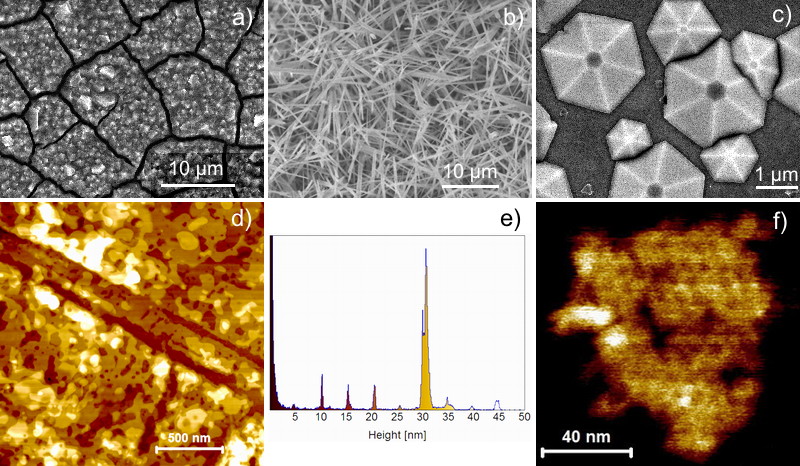Internship proposal
Contacts : Catherine Henry de Villeneuve and Michel Rosso
Postdoc : Weichu Fu
PhD students : Hongye Yuan (thesis 2017), Weichu Fu (thesis 2023)
MOFs (Metal Organic Frameworks) are porous crystalline solids obtained by self-assembly of metal ions and organic ligands. Their remarkable porosity (specific surfaces> 1000 m2 / g) much higher than that of inorganic materials (zeolites, carbon or silica), coupled with structural (size and shape of pores) and / or physicochemical properties adjustable by the choice of precursors make them materials with high potential for many applications (fluid storage, molecular separation, (photo) catalysis, sensors, (opto) electronics, photovoltaics, batteries, etc.). These materials are generally synthesized in the form of micro (nano) crystalline powders. Significant research efforts are currently aiming at their shaping on solid surfaces with a view to their integration into devices.

Figure 1 : Growth of MOFs on silicon surfaces functionalized by grafting an organic monolayer terminated by ligands.
In this context we are interested in the production of thin MOF layers by direct growth on surfaces. We are studying growth on silicon surfaces whose structural properties and / or surface chemistry can be adjusted by grafting organic monolayers (fig. 1). An originality of our approach is to develop growth procedures on model (111) silicon surfaces which allow the implementation of highly sensitive characterization techniques (AFM microscopy, ATR-FTIR spectroscopy).
Our current work focuses on the growth of Fe-based MOF and carboxylate ligands. From the same precursors, namely the Fe3+ ions and the 1,4-benzene dicarboxylic acid (BDC), different MOFs are obtained depending on the synthesis conditions (surface chemistry, composition of the solution, temperature) : layers of variable morphologies and crystalline phases with, in some cases, a preferential orientation (texturing) (fig. 2). Particularly interesting and original results are the formation of textured 2D thin layers (thickness <50 nm) (fig. 2d) and the structural identification of very small particles (thickness of a few nm) by highlighting a hexagonal network of pores by high resolution AFM imagery (fig. 2f).
Figure 2 : Examples of Fe3+ - based MOFs and 1,2-Benzene Dicarboxylate (BDC) ligands obtained on silicon surfaces functionalized with a monolayer of carboxylic acids.
Images (a, d, f) show the growth of the same crystalline phase (cubic MIL 101) but with different structural properties: (a) SEM image of a thick (∼ 1 µm) poly-crystalline layer (XRD diagram similar to that of a powder), (d) AFM image showing a thin layer (<50 nm) structured in flat terraces separated by regular steps. The height histogram (e) indicates a characteristic step height corresponding to the reticular distance d111 = 5.13 nm of the MIL 101 cubic structure indicating a 2D oriented growth with a texture (111). This type of growth is also highlighted in the high resolution AFM image (f) showing a 2D particle on which an ordered network of pores is observed (darker spots). Detailed analysis of the image indicates a hexagonal symmetry and an average distance dpore ∼ 6 nm corresponding to the distance between large pores in the MIL 101 structure. (b, c) SEM images showing the growth of two other crystalline phases: (b) "needles" of orthorhombic MIL 68 structure, (c) hexagonal pyramids of MIL 88B type with a (001) texture.
Publication :
H. Yuan, W. Fu, N. Soulmi, C. Serre, N. Steunou, M. Rosso, and C. Henry-de-Villeneuve, "Growth of Fe-BDC Metal Organic Frameworks onto functionalized Si (111) surfaces", Chemistry - An Asian Journal 17 (2022) e202200129.


